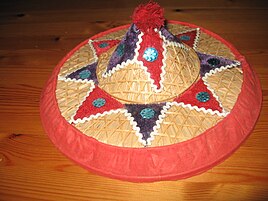Jaapi or Japi (Bodo: Khofri) is an Asian conical hat from Assam, India. It is made from tightly woven bamboo and/or cane and tokou paat (Trachycarpus martianus) a large, palm leaf. The word jaapi derives from jaap meaning a bundle of tokou leaves. In the past, plain jaapis were used by ordinary people in Assam and by farmers for protection from the sun, while ornate decorative jaapis were worn as a status symbol by the royalty and nobility. Decorative sorudoi jaapi are made with intricate cloth designs (primarily red, white, green, blue, and black) that are integrated into the weaving.
 An Assamese Jaapi | |
| Related instruments | |
|---|---|
History
Originally a jaapi was an agricultural headgear used by farmers to protect themselves from the rain or the heat of the sun. The Bodo-Kacharis, the indigenous people of Assam, used plain japis while farming. Similar headgears were also used all throughout Southeast Asia and East Asia.[4] Bishnu Prasad Rabha innovated the japi dance to mainstream Assamese culture, through its use in Joymoti movie, from the Khofri Sibnai Mwsanai dance of the Bodo people.
The medieval Chutia kings used the jaapi as a cultural symbol. The last Chutia king gifted gold and silver embroidered Jaapis (Kup-ngiun-kham) to the Ahom king Suhungmung (1497–1539) as presents in his attempts for a treaty in the year 1523.[5][6] After annexing Sadiya in 1524, the Ahom king received a lot of treasure and bounty, which included Jaapis.[7] In the year 1525, the Ahom king gifted some of the silver Jaapis obtained from the Chutia king and other items, to negotiate peace with the Mongkawng chief Phukloimung, a Shan state in present Kachin State of Upper Myanmar (called Nora in Buranjis) who had attacked Sadiya.[8] During the Ahom rule, Jaapi-hajiya Khel (guild for making Jaapis) was monopolised by Chutias, which indicate that they were experts in weaving Jaapis.[9] Apart from this, the Baro-Bhuyans of Central Assam are also said to have used Jaapis. As per the Satsari Buranji, the Ahom kings adopted the Tongali, Hasoti and Tokou-patia Japi from the Baro-Bhuyans.[10]
- Upper metal part of an ancient Varun (Tupi) Japi known as Sula used during the rule of Chutia kings kept in the Gharmora Satra.
- Sarudaya jaapi
- An ornately made jaapi
- A jaapi at Kalakhetra, Guwahati
- Jaapis made in Dhemaji
Cultural symbol
Today the jaapi is an important symbol of Assam and its culture. It is used during Bihu dance, as protection against the elements, offered as a sign of respect in ceremonies, and placed as a decorative item around the house especially in the walls as a welcome sign.[11][12]
Types
- Sorudoi japi: Used by women, especially brides.
- Bordoi japi: Used by royalty since ancient times (Kamrupa).
- Panidoi/Haluwa japi: Used by farmers in fields.
- Garakhiya japi: Used by cattle herders.
- Pitha japi: Used as hoods, sometimes during cultivation.
- Tupi/Varun japi: Used in rain as protective hats.
See also
References
External links
- Dutta, Sristidhar (1985), The Mataks and their Kingdom, Allahabad: Chugh Publications
- Khanikar, S (1991), Chutia Jaatir Itihax aru Luko-Sanskriti
- Bhuyan, Surjya K. (1960), Satsari Buranji
- Handoo, Jawaharlal (2003), Folklore in the Changing Times, Original from Indiana University: Indhira Gandhhi Rashtriya Manav Sangrahalaya
- Mahanta, S (1945), Assam Buranji.D.H.A.S.
- Some information about Assamese culture





